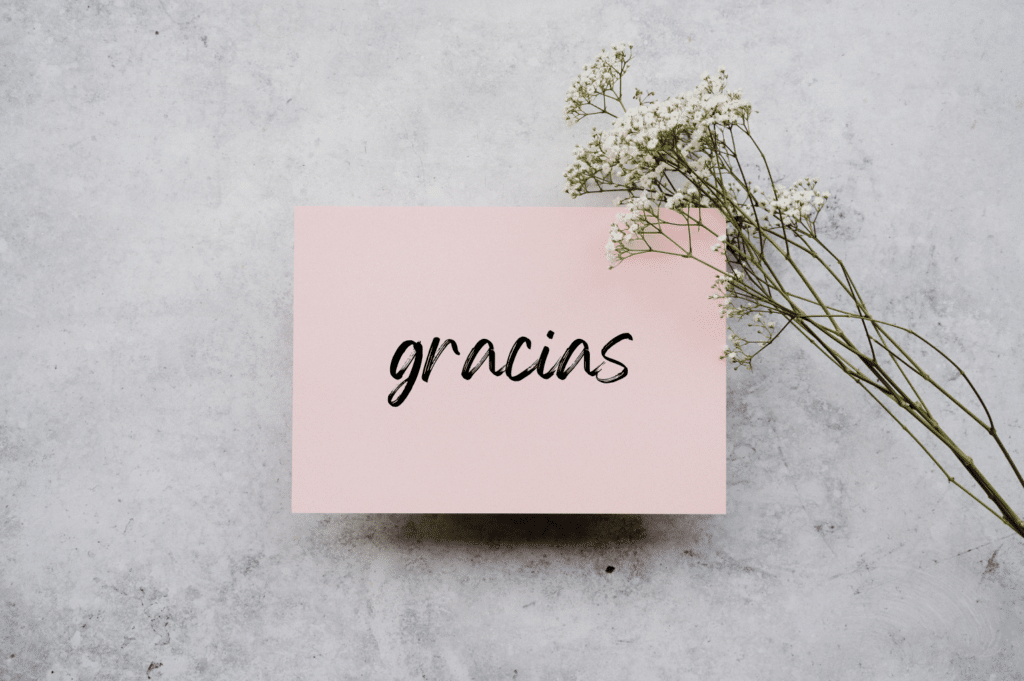
30 Ways to Say “Thank You” in Spanish
If you’re learning Spanish, “thank you” is one of the first things you should learn how to say.
It shows good manners and allows you to express your gratitude to the Spanish speakers in your life.
The most common and straightforward way to say thank you in Spanish is gracias. But there are many other ways to communicate your thanks.
In this post, you’ll learn 30 unique ways to say thank you in Spanish. After this, you can move on to master you’re welcome in Spanish next.
Contents
- How to Say Thank You in Spanish
- Verbs to Express Gratitude in Spanish
- How to Practice Saying Thank You in Spanish
Download: This blog post is available as a convenient and portable PDF that you can take anywhere. Click here to get a copy. (Download)
How to Say Thank You in Spanish
Here are some different ways to say thank you in Spanish, commonly used by native speakers to express their gratitude:
| Spanish | English | Explanation |
|---|---|---|
| Gracias | Thank you | This is the most common and straightforward way of thanking someone in Spanish. |
| Muchas gracias | Thank you so much | When you're very thankful, you can literally give many thanks to the other person. |
| Muchísimas gracias | Thank you so much / Thanks a lot | Using the augmentative -ísimas makes this expression more intense. |
| (Muchas) gracias por todo | Thank you (so much) for everything | This is a nice expression to thank someone after they've hosted you for dinner, for example. |
| Mil gracias | Thanks a million / Thank you so much | The literal translation of this phrase is "a thousand thanks." |
| Un millón de gracias | Thanks a million | This literally translates to "a million thanks" and is less common than mil gracias. |
| Gracias mil veces | Thank you a thousand times | This is another variation of the last two expressions. |
| Gracias infinitas / Infinitas gracias | Infinite thanks | This phrase is used both ways to express deep gratitude. |
| Gracias de nuevo | Thanks again | Use this phrase to re-iterate your appreciation. |
| Gracias igual / Gracias de todos modos | Thanks anyway | If someone can't help you, this is a good way to express your gratitude for their attempt or intention. |
| Muy amable | That's very kind of you | This polite phrase translates literally to "very kind" and you can use it, for example, with restaurant staff. |
| Gracias a todos | Thanks, everyone | Note the use of the personal a in this phrase. For all females, you'd use todas. |
| Gracias, ¡qué lindo! | Thanks, how nice! | This is commonly used when thanking someone for something nice they've done or given you. |
| Gracias de antemano | Thanks in advance | Antemano literally means "beforehand." |
| Gracias a Dios | Thank God | This is a common expression used by religious Spanish speakers. For example: "Llegamos sanos y salvos, gracias a Dios." (We arrived safely, thank God.) |
| Gracias a ti
Gracias a usted | Thanks to you | When someone thanks you, you can respond with this phrase to reciprocate the appreciation. You can also just say "a ti" (informal) or "a usted" (formal). |
| Se agradece | It's appreciated | Note that this phrase uses the Spanish passive voice. |
| Estoy muy agradecido / agradecida | I'm very thankful | Remember to choose the correct form of the adjective agradecido, depending on the gender and number of the speaker(s). |
| Te doy (las) gracias
Le doy (las) gracias | I thank you (informal, formal) | This phrase literally means "I give you thanks" and is a less common form of saying gracias. Use te with friends and family and le with people you're not so close to or with older people to show respect. |
| Te lo agradezco
Se lo agradezco | I thank you | Remember that we never say le lo or le la and instead change the le to se. |
| Te lo agradezco de (todo) corazón
Se lo agradezco de (todo) corazón | I thank you from the bottom of my heart | This is an adaptation of the previous phrase and expresses deep and honest gratitude. |
| Te lo agradezco en el alma
Se lo agradezco en el alma | Thank you from the bottom of my soul | This literally means "I thank you in the soul." |
| Te lo agradezco profundamente
Se lo agradezco profundamente | I thank you deeply | This is another rather formal, heartfelt way of expressing your gratitude. |
| Te estoy eternamente agradecido
Le estoy eternamente agradecido | I'm eternally grateful to you | This is a rather formal expression to express your thanks. You can also shorten it to eternamente agradecido/a. |
| No tengo palabras para agradecerte
No tengo palabras para agradecerle | I have no words to thank you (informal, formal) | If you just can't find the words to express your thanks, this is a nice expression you can use. |
| No sé cómo agradecerte
No sé cómo agradecerle | I don't know how to thank you | Similar to the one above, this expression can be used when you're overwhelmed with gratitude. |
| Te debo mucho
Le debo mucho | I owe you a lot | While not necessarily a form of "thank you," you can respond with this phrase when someone does you a big favor. |
| Es muy amable de tu parte
Es muy amable de su parte | That's very kind of you (informal, formal) | The possessive adjective tu (your) is used in informal situations, whereas su (your) is used in formal situations, where you would address the person with usted (you, formal). |
| Tu apoyo es invaluable
Su apoyo es invaluable | Your support is invaluable (informal, formal) | This is a nice way to acknowledge someone's support that goes well beyond a basic "thank you." |
| ¡Te pasaste!
¡Se pasó! | You shouldn't have! | This is an informal phrase that literally means "you passed yourself." With a different tone, it can also mean something like "you crossed the line." |
It’s important to note that when thanking someone for something specific, we use “Gracias por…” and not “Gracias para…,” which is a common mistake made by Spanish learners. For example:
Gracias por venir a mi fiesta de cumpleaños. (Thanks for coming to my birthday party.)
Gracias por el lindo regalo. (Thanks for the nice gift.)
Verbs to Express Gratitude in Spanish
Aside from the common expressions for saying thank you above, we also have a set of verbs that you can use to talk about giving thanks.
Agradecer — To thank, to appreciate
Agradecer is an irregular verb that’s conjugated like conocer (to meet/to get to know). It’s normally used in the first person, both singular and plural:
Le agradezco la ayuda. (I thank you for your help.)
Le agradecemos la ayuda. (We thank you for your help.)
The adjective agradecido (thankful) appears in the expression estar agradecido (to be thankful). For example:
Estoy muy agradecido por su ayuda. (I’m very thankful for your help. — male speaker, formal)
Estamos muy agradecidas por tu ayuda. (We’re very thankful for your help. — female speakers, informal)
The noun agradecimiento (gratitude) is typically only used in rather formal contexts. It tends to be part of the expressions mostrar agradecimiento (to show gratitude) and en/como señal/muestra de agradecimiento (as a token of gratitude).
Quiero mostrarles mi agradecimiento a todos los voluntarios. (I want to show my gratitude to all the volunteers.)
Le envió flores como señal de agradecimiento. (He sent her flowers as a token of gratitude.)
Apreciar — To appreciate
The verb apreciar is a regular verb you can use when you want to say a bit more than just a simple “thank you.” It’s followed by what you’re thankful for or what you appreciate:
Aprecio mucho tu honestidad. (I really appreciate your honesty.)
Apreciamos que hayas venido a vernos. (We appreciate you coming to see us.)
Dar las gracias — To give thanks
Dar las gracias is probably the most commonly used verb of the three on this list. It’s used both in formal and informal situations when you want to mention what you’re thankful for.
Queremos darte las gracias por tu ayuda. (We want to thank you for your help.)
Me dio las gracias por decir la verdad. (He thanked me for telling the truth.)
How to Practice Saying Thank You in Spanish
The best way to practice saying thank you is by going to a Spanish-speaking country and thanking all the people who give you directions, serve you food and drinks, etc. But to build your confidence and familiarity from home, there are a few things you can do.
To get familiar with when these phrases should be used, watch how native speakers use them. If you don’t know any Spanish speakers, you can find language exchange partners online or watch Spanish movies and TV shows. There are also many useful videos on YouTube, like this one:
You can also use a language learning program like FluentU to see these phrases used in context. FluentU has a huge library of short video clips from authentic Spanish media—from music videos to news reports to commercials—which let you see how natives speak the language.
Each video comes with interactive subtitles, and you can use the video dictionary to better understand how to use phrases like mil gracias.
By seeing how the language is spoken in different contexts, you’ll pick up more natural-sounding Spanish. Check out the website, or download the app on iOS or Android app to learn on the move.
Saying thank you can help you connect with others and show them how much you appreciate them or their efforts.
By learning some of these expressions, you can express your gratitude to Spanish speakers with confidence and ease.
Download: This blog post is available as a convenient and portable PDF that you can take anywhere. Click here to get a copy. (Download)






